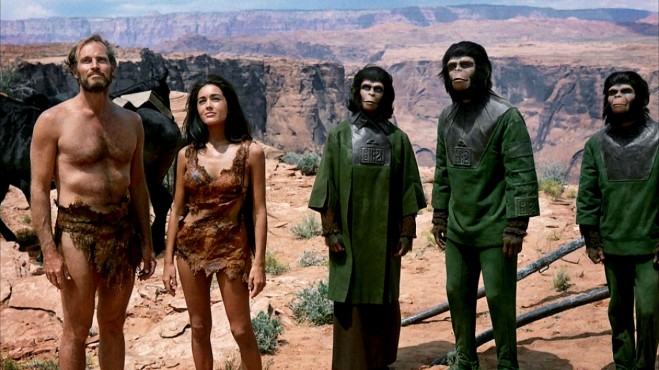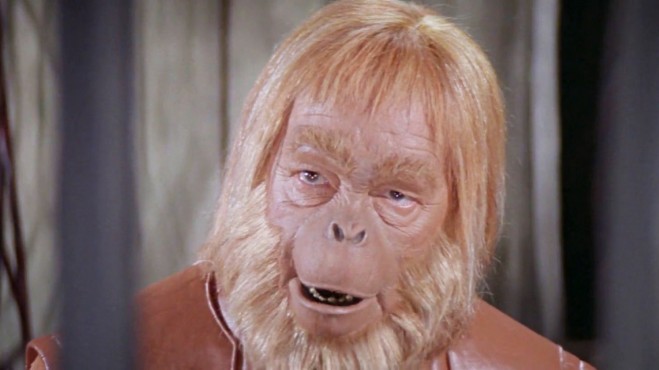
We all know Planet of the Apes. Even if you’ve never seen the movie you know how it ends. You’ve probably heard the film’s most iconic line of dialogue as well “Take your stinking paws off me, you damn dirty ape!” Planet of the Apes is a film so ingrained in pop culture that even forty-odd years later it’s remembered clearly and fondly.
Not only is Planet of the Apes a film that excels on a technical and entertainment level, it excels on a sociological level. Because great sci-fi movies are more than robots and spaceships. They are social commentary. Sci-Fi movies are a reflection of our society plunged into a world of technological achievement or sometimes even the downfall of technology. They portray both utopias and dystopias and how they came to be and what we can learn from them. This is why Planet of the Apes is great.
The film tells the story of astronaut Taylor (Charlton Heston) and his fellow crew mates Landon (Robert Gunner) and Dodge (Jeff Burton) after their ship crashes on a strange planet thousands of years into the future. On the planet, the astronauts discover a primitive race of people, but it’s not the people who are in charge, it’s DAMN DIRTY APES! Yes, they walk, they talk, they even have science and religion. Yet the apes are blinded by ignorance and a hatred towards humans. This is witnessed after the apes kidnap Taylor and his men and put them in a zoo. Thus, Taylor’s only hope is to convince a psychologist chimpanzee Zira (Kim Hunter) and her archeologist husband Cornelius (Roddy McDowall) of his intelligence and connection to the apes.
Based on the 1963 novel by Pierre Boulle, (also the author of Bridge on the River Kwai), Planet of the Apes is a study of class separation and how blind faith can shield discovery and enlightenment. This is interesting considering the film starred Charlton Heston, known in his later years for his strong conservatism, Christian values, and NRA affiliation… Well, that last one makes sense.
Perhaps the 1960s were such a radical time that even Heston was open to exploring bold ideas. Of course, no one did a better job of adapting social issues and turning them into nightmares than Twilight Zone creator Rod Serling. Serling not only co-authored the script, he was also responsible for the film’s twist ending. You know what I’m talking about, “They blew it up damn it!” The script was polished by veteran script doctor Michael Wilson (The Bridge on the River Kwai, Lawrence of Arabia) and put under the helm of director Franklin J. Schaffner (Patton), and the rest is history.
A landmark in science fiction storytelling, the film was also a landmark in technical achievement. The film’s groundbreaking makeup effects were so heralded, the film received an honorary Oscar for makeup artist John Chambers (the guy who John Goodman played in Argo). The film also nabbed nominations for Best Costume Design (Morton Haack) and original score, Jerry Goldsmith. That aside, I’m going to take a moment to honor my favorite piece in this puzzle, Charlton Heston.
Charlton Heston has always had a unique ability to overact to an almost Shakespearian degree. Yet his performances are very American. There’s a poetry to Heston’s delivery, but it’s a tough guy poetry. His performances hit all over the map, but are always entertaining. My favorite scene is when Heston’s Taylor laughs at his crew member after he plants an American flag on “alien” soil. There’s a bizarre zoom followed by Heston’s maniacal laugh that I’ve never understood. It’s great. The only other performance in the film that comes close to matching his energy is Maurice Evans as the cantankerous Dr. Zaius. When Taylor and Zaius square off, it’s comedy, drama, and full-on entertainment all in one. It’s more fun than a barrel full of whatchamacallits.
I am a big fan of Planet of the Apes for more reasons than I can name. The question being, “Will my love for Planet of the Apes be enough to help me appreciate the franchise that followed?” We’ll find out next time when I go Beneath the Planet of the Apes.


